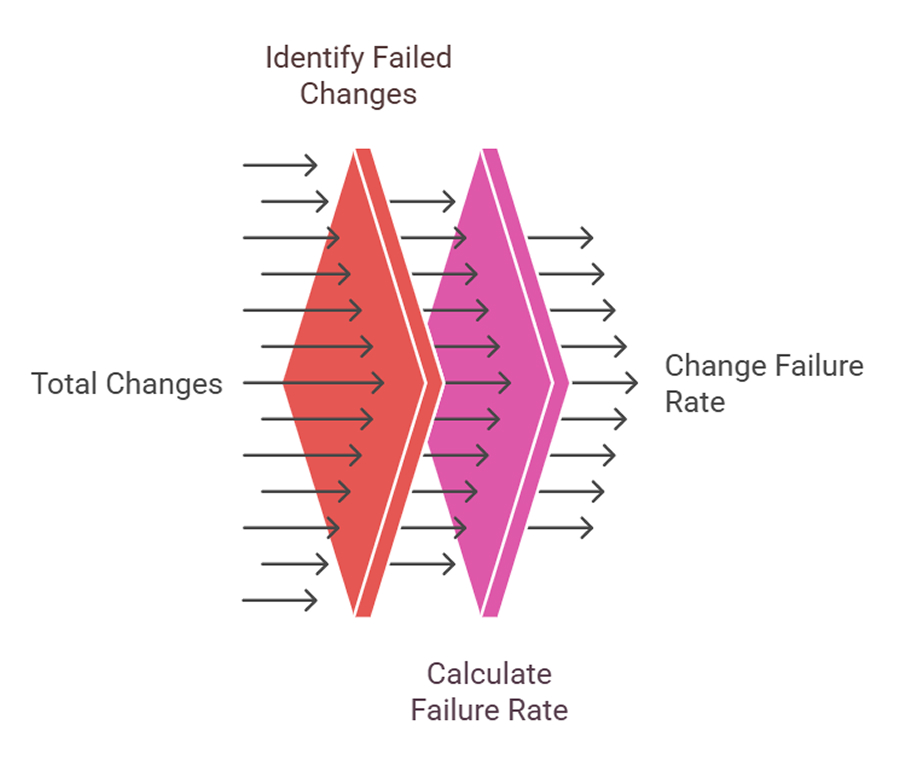With the rapid digitization in many industries, everyone is trying to be first in the market. As a result, software developers are under constant pressure to deliver quickly without sacrificing quality. To achieve this, they need to make correct decisions using clear metrics. One of the most important is Change Failure Rate (CFR).
CFR is one of the four key DORA (DevOps Research and Assessment) metrics, and it offers valuable insight into how stable and reliable your development process really is.
What is Change Failure Rate?
Change failure rate measures the percentage of code changes that result in failures in production.
How do you measure change failure rate?
Change Failure Rate = (Number of Failed Changes / Total Number of Changes) × 100%
A “failed change” typically refers to any deployment that:
- Causes service degradation or outage requiring immediate remediation.
- Introduces bugs or defects that necessitate a hotfix or rollback.
- Fails to function as intended, requiring immediate attention.
For example, if your team deploys 20 changes in a week and 5 of them result in failures requiring remediation, your CFR would be 25%.

Why Does Change Failure Rate Matter?
The significance of CFR extends beyond merely tracking failures:
1. Quality Indicator
- A high CFR signals underlying issues in your development lifecycle.
- For example, it could point to inadequate testing, rushed code reviews, or architectural flaws.
2. Team Health Barometer
- Consistently high failure rates often correlate with team burnout.
- This creates a negative cycle where rushed work leads to more failures, increasing stress and reducing productivity.
3. Business Impact Measurement
Failed changes directly impact business outcomes through:
- Lost revenue during service disruptions
- Diminished customer trust
- Reduced team velocity as resources shift to remediation
- Increased operational costs
4. Process Maturity Assessment
DORA classifies teams into performance categories: elite, high, medium, and low, based on metrics like CFR. Elite performers typically have a CFR of 0–15%, helping teams benchmark their maturity and stability against industry standards.

Strategies to Accelerate Change Failure Rate
Reducing your CFR requires a multifaceted approach:
1. Implement Robust Testing Practices
Comprehensive testing is your first line of defense. Consider:
- Expanding unit test coverage.
- Implementing integration tests that validate system behavior.
- Adding automated UI testing for critical user journeys.
- Conducting performance testing before production deployment.
2. Adopt Feature Flags
Feature flags allow you to decouple deployment from release, enabling:
- Gradual rollouts to limit the blast radius of potential issues.
- Kill switches to quickly disable problematic features.
- Controlled experimentation without risking overall system stability.
3. Enhance Monitoring and Observability
You can’t fix what you can’t see. Implement:
- Real-time performance dashboards.
- Detailed error tracking and exception monitoring.
- User experience metrics.
- Business outcome measurements.
4. Define Code Review Processes
Many failures can be caught before deployment through:
- Enforcing peer reviews with defined checklists.
- Involving senior developers in reviews of critical components.
- Using automated static analysis tools.
- Documenting lessons learned from previous failures.
5. Implement Smaller, More Frequent Deployments
Large, infrequent deployments carry higher risk. By breaking changes into smaller units, you can:
- Reduce complexity per deployment.
- Make issues easier to identify and isolate.
- Limit the scope of potential failures.
- Enable faster recovery when problems occur.
Measuring Change Failure Rate Effectively
To derive maximum value from CFR tracking:
- Ensure your team has a shared understanding of what constitutes a “change” and a “failure.”
- Target continuous improvement rather than aiming for zero failures (which may discourage innovation).
- Different types of changes carry different risk profiles. Consider tracking separate CFRs for:
- Infrastructure changes
- Frontend features
- Backend services
- Data model modifications
- Track trends, not just numbers: A temporary spike in CFR during a major architecture overhaul might be acceptable, while a gradual increase during routine development signals trouble.
Balancing Speed and Stability
Improving CFR doesn’t mean slowing down delivery. In fact, DORA research consistently shows that high-performing teams achieve both lower failure rates and higher deployment frequencies.
Instead of waiting for the end to see if a product meets the expected standard, quality should be treated as an integral part of the entire procedure. With the implementation of automation, observability, and continuous training, teams are able to improve stability, which leads to faster delivery with increased confidence.
Conclusion
Change failure rate is a key health indicator for your development process. By consistently tracking and working to reduce it, teams can achieve what often seems impossible: shipping faster without sacrificing stability.
Improving CFR leads to more than just cleaner deployments. It strengthens customer experience, boosts team confidence, and results in more predictable development cycles.
However, the goal isn’t to avoid every failure but to learn from them quickly and prevent them from happening again. When seen this way, CFR becomes more than a metric. It becomes a driver of continuous improvement.
